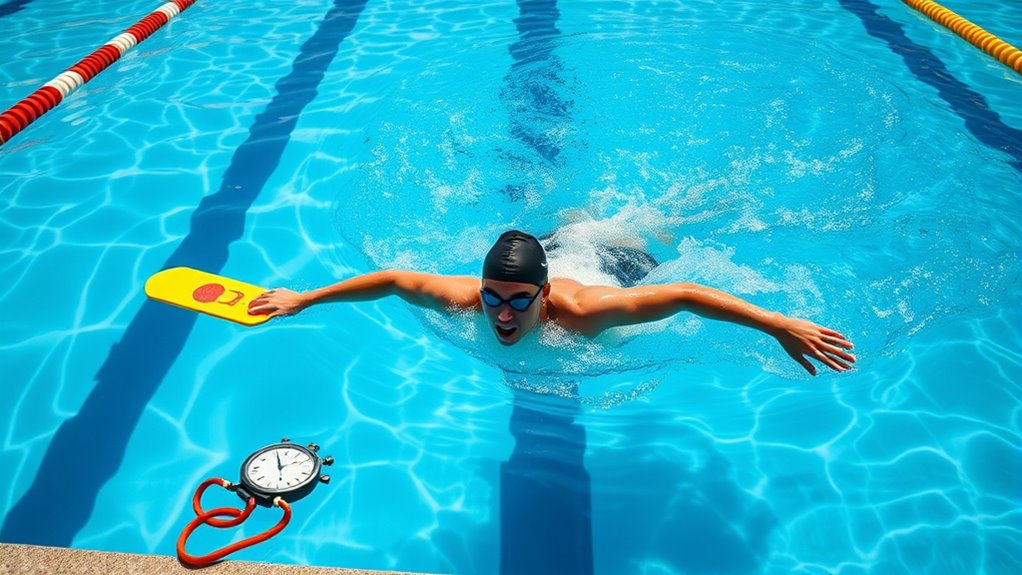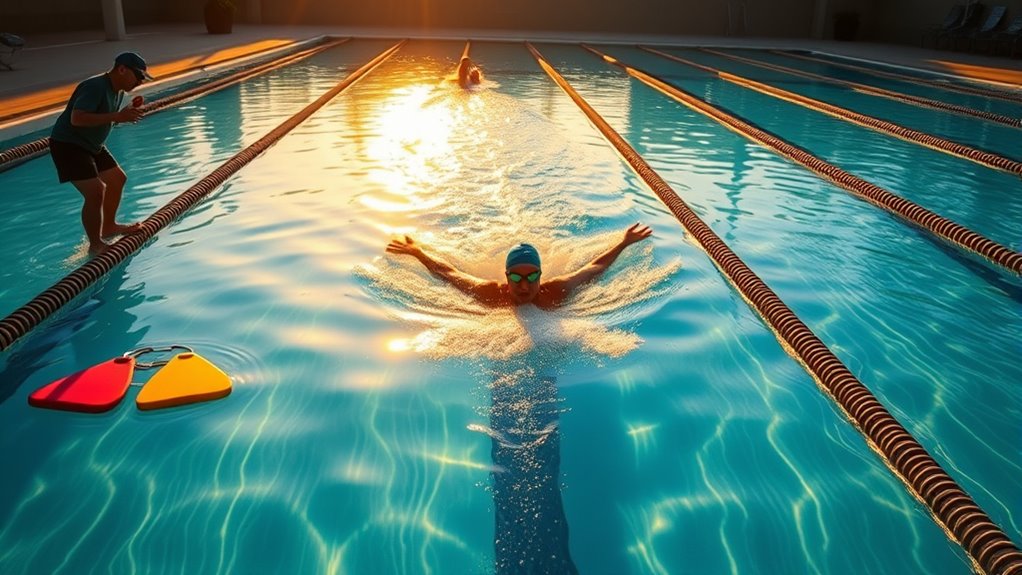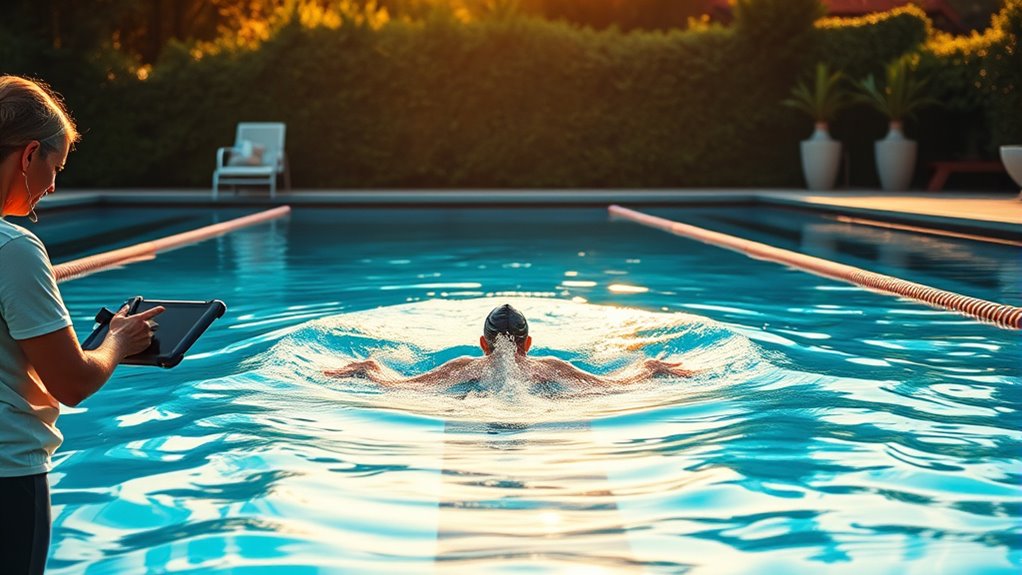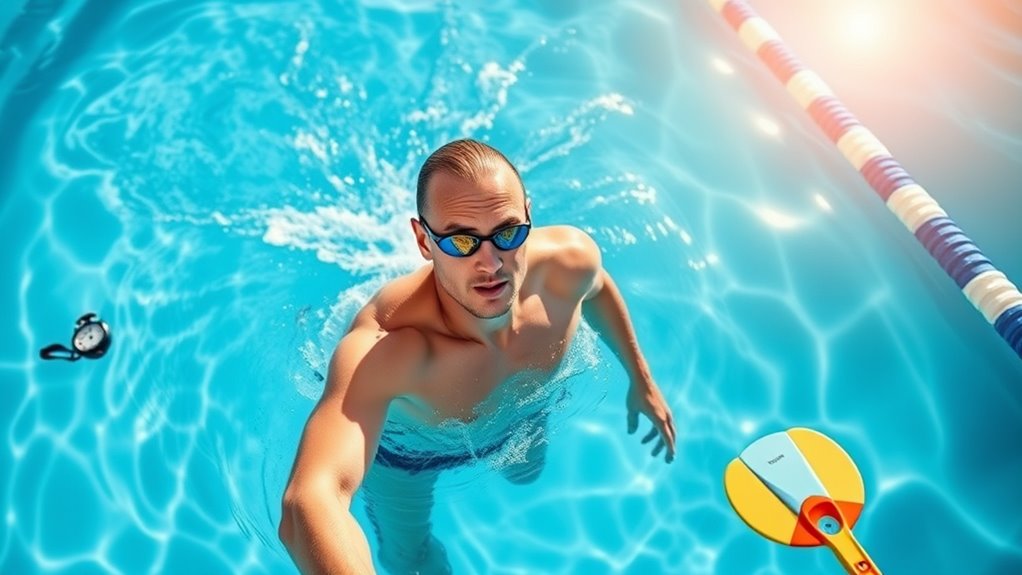To create the ultimate pool workout, start by evaluating your fitness goals and skill level. Incorporate a mix of laps at steady paces, high-intensity sprints, and gentle recovery swims to boost endurance and strength. Don’t forget to include warm-up and cool-down periods to prevent injuries. Focus on good technique throughout, and use water-based stretching and relaxation strategies afterward. Keep exploring techniques to optimize your routine for better results.
Key Takeaways
- Structure your workout with varied laps, incorporating high-intensity sprints and recovery swims to boost endurance and strength.
- Include warm-up and cool-down periods to prevent injury, promote recovery, and enhance flexibility.
- Use interval training with precise timing or lap counts, adjusting durations based on your fitness level.
- Integrate water-based stretching and resistance exercises like kickboard drills for improved flexibility and circulation.
- Focus on proper technique and deep breathing throughout to maximize benefits and prevent injuries.
Setting Up Your Pool Workout Routine

To create an effective pool workout routine, start by evaluating your fitness goals and current skill level. Are you aiming for weight loss, muscle toning, endurance, or recovery? Knowing this helps you tailor your plan. Next, assess your swimming ability—are you a beginner, intermediate, or advanced swimmer? This determines the intensity and complexity of your exercises. Consider your available time and the equipment you have, like kickboards or paddles, which can enhance your workout. Set realistic, measurable goals to stay motivated. Remember to include warm-up and cool-down periods to prevent injury and promote recovery. By clarifying your objectives and understanding your current abilities, you’ll set a solid foundation for an effective, personalized pool workout routine. Incorporating knowledge about juice cleanses and detox can also inspire hydration strategies to optimize your performance and recovery.
Structuring Effective Laps and Interval Training

Incorporating structured laps and interval training into your pool workout can substantially boost your fitness results. To maximize effectiveness, vary your pace and distance, alternating between high-intensity sprints and recovery swims. This approach challenges your muscles and improves endurance. Use a timing method or lap count to stay consistent, and adjust intervals based on your fitness level. Here’s a simple example to get started:
| Interval Type | Duration | Purpose |
|---|---|---|
| Warm-up | 5 minutes | Prepare muscles |
| Sprint | 30 seconds | Increase speed and power |
| Recovery swim | 60 seconds | Rest and catch your breath |
| Main set | 4-6 rounds | Build endurance and strength |
| Cool-down | 5 minutes | Relax muscles and recover |
Additionally, paying attention to good technique can help prevent injuries and ensure you get the most out of your workouts.
Incorporating Recovery and Cool-Down Strategies

After intense laps or interval training, prioritizing recovery and cool-down strategies helps your body repair and reduces soreness. Begin with gentle swimming at an easy pace to gradually bring your heart rate down. Focus on deep, controlled breathing to relax your muscles and improve oxygen flow. Stretch your arms, shoulders, and legs in the water to release tension and enhance flexibility. Consider using a foam noodle or kickboard for light resistance exercises that promote circulation. Hydrate well and consume a balanced snack to replenish energy stores. Avoid stopping abruptly; instead, ease into a slow swim. Incorporating these routines ensures your muscles recover faster, minimizes stiffness, and prepares you for your next workout. Consistent recovery practices maximize your overall swimming performance. Additionally, integrating post-exercise stretching with your cool-down routine can further aid in muscle recovery and flexibility.
Frequently Asked Questions
What Are the Best Pool Exercises for Beginners?
As a beginner, start with simple exercises like walking or jogging in the water to build comfort. Practice basic strokes such as freestyle and backstroke to improve technique. Incorporate water aerobics or gentle treading to boost endurance. Focus on controlled breathing and smooth movements, gradually increasing your time and intensity. These exercises help you gain confidence, improve strength, and make swimming enjoyable without feeling overwhelmed.
How Often Should I Change My Pool Workout Routine?
You should change your pool workout routine every 4 to 6 weeks. This prevents plateaus, keeps your muscles challenged, and maintains your motivation. As you progress, adjust your exercises, intensity, or duration to match your goals. Listen to your body—if you notice signs of fatigue or boredom, it’s time for a new plan. Regularly varying your routine guarantees continuous improvement and keeps swimming engaging.
Can Pool Workouts Help With Joint Pain?
Yes, pool workouts can help with joint pain. The water’s buoyancy reduces pressure on your joints, making movement easier and less painful. Regular swimming or water exercises strengthen muscles around affected joints, providing better support and stability. Plus, the gentle resistance improves flexibility and range of motion. Just start slow, listen to your body, and consult a healthcare professional if you have severe or chronic joint issues to guarantee safe exercise.
What Equipment Is Essential for an Effective Pool Workout?
Did you know that 75% of pool workout enthusiasts find equipment boosts their performance? For an effective pool workout, you’ll need a kickboard to improve leg strength, waterproof resistance bands for added muscle work, and a swim fins set to enhance propulsion. A waterproof timer helps track your progress, and a pull buoy assists with upper body focus. These essentials make your swim more efficient and engaging, maximizing benefits with less effort.
How Do I Track Progress in Pool Training?
You can track your progress by keeping a detailed workout journal, noting your lap times, distances, and how you feel after each session. Use a waterproof fitness tracker or smartwatch with swim-tracking features to automatically record data like strokes, pace, and calories burned. Regularly review your stats to identify improvements, set new goals, and stay motivated, ensuring your training stays focused and effective.
Conclusion
By following this ultimate pool workout, you’ll transform into an unstoppable swimming machine, slicing through water like a lightning bolt. Your stamina will skyrocket, and recovery will become smoother than silk. Before you know it, you’ll be conquering pools with the power of a tidal wave, leaving everyone in awe. Immerse yourself, push your limits, and watch your confidence and strength surge to heroic levels—because once you master this routine, there’s no stopping you!









